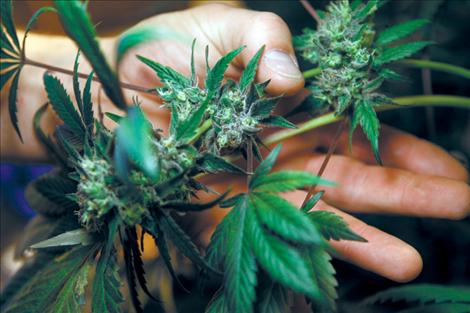State legislature considers marijuana DUI bill
Hey savvy news reader! Thanks for choosing local.
You are now reading
1 of 3 free articles.
HELENA — Montana legislators are considering a bill that would create a legal driving limit of 5 nanograms of THC (the active ingredient in marijuana) per milliliter of blood for recreational drug users.
As recreational use of marijuana is still illegal, this law will effectively create a legal limit for the amount of an illegal drug present in a Montana driver’s bloodstream. Most states have a zero-tolerance policy.
House Bill 168 was introduced by Rep. David “Doc” Moore of Missoula. Moore said the bill is not about taking medical marijuana away from them and the bill will have a zero fiscal note with it.
“Especially with some of the fatal accidents, we’re seeing more and more of this type of impaired driving,” Moore said.
Moore said it doesn’t matter what people do at home; it’s getting behind the wheel of a car while impaired that is the problem.
“We have to start somewhere; we can’t ignore that there’s a problem,” he said. “All I know is that people are being injured or killed on the highway because of impaired driving. If people would practice personal responsibility and not get on the road, we would not have the need for this kind of legislation.”
The bill is very similar to one adopted by Washington after the state fully legalized marijuana for recreational use.
Sarah Braseth, a forensic toxicologist with the Montana State Crime Lab, was present during the Montana legislature’s first committee meeting on the bill and testified as to the 5ng THC level, what it means and what crime labs can and cannot do.
“The main goal (of HB 168) is to get some awareness out there that marijuana is impairing and to get people to, hopefully, think twice about driving. It is a problem and we’ve seen an increased number of fatalities with marijuana ... It seems there’s an issue and I think they’re trying to address that,” she said.
“Developing science based per-se limits for driving under the influence of cannabis,” is the major study referenced by Braseth, HB 168 and several other government agencies attempting to create per se limits for DUI-cannabis. The study, published in 2005, combines more than 20 cannabis studies. The studies’ summary and discussions section reads, “Scientific evidence on cannabis and driving is not yet sufficient to permit the selection of a numerical enforceable THC limit with the same level of confidence as for alcohol .... However, the combined findings and conclusions from epidemiological and experimental studies on cannabis and driving offer an initial science-based foundation for a legal limit.”
The summary goes on to say the results of 20 studies on cannabis and driving are “somewhat inconsistent” and the most recent, meaningful studies indicate drivers with a THC concentration of less than 5ng/ml have a crash risk no higher than sober drivers. Crash risks seem to increase in the 5-10ng/ml range, but “because recent studies found only a few drivers with THC concentrations in that critical range, a reliability assessment of the associated crash risk is still lacking.
“Even frequent users of cannabis do not seem to have a higher accident risk than nonusers, as long as they are not under the acute influence of the drug, i.e., there appear to be no effects of prolonged cannabis use on traffic safety. Any long-term impairment by cannabis would be reflected in an overall high crash risk of drivers testing positive for THC-COOH. However, no such increase was found in culpability studies.”
HB 168 deals with only the amount of active ingredient (THC) in the bloodstream, not metabolites. Even so, Braseth said there is no direct conclusion in the scientific community that says 5 ng/ml would be comparable to a .08 percent limit for blood alcohol concentration.
“The two drugs are so different in the way they’re metabolized and taken, they’re too hard to compare. It’s like comparing apples and oranges,” she said.
The breathalyzer test has been used to detect an individual’s blood alcohol content for many years. Pocket or keychain sized models, while not as accurate as the models used by law enforcement, can be purchased for less than $100 in most electronics stores.
No such device exists for measuring a person’s THC blood levels. The only equipment capable of performing such a task resides in the state crime lab in Missoula.
As marijuana is illegal without a prescription, “No one knows the percentage of THC in plant material being grown and sold,” Braseth said.
In addition, there is no quality control or oversight of marijuana growing operations. Therefore, there is no way for a recreational user to measure the exact amount of THC they are ingesting, nor is it possible for users to test their blood THC level to find if they are legally able to drive.
A user’s blood-THC level also depends on the method of use.
Cannabis users ingest marijuana through several methods, including smoking the dried plant and eating foods cooked with cannabis as an ingredient.
“The level of THC you get in the blood would depend on how you’re using it or smoking it or eating it,” Braseth said. “If you’re smoking it, the levels in your blood rise pretty rapidly and peak; then your body starts to metabolize the THC.”
Braseth said an hour or two after smoking, she would expect to see THC levels in the blood fall below 10 ng/ml. After four hours, an occasional smoker’s blood-THC levels would be below detection.
Moore said he’d been on a ride along with law enforcement and witnessed an alcohol DUI firsthand, start to finish. Moore said the average DUI takes two to four hours to process. This means that should the bill become a law, a severely impaired individual with a THC blood level at double the legal limit at the time he was pulled over might very well be below the legal limit by the time officers are able to obtain a warrant for his blood.
Braseth said she has seen an increase in these kinds of cases, as officers receive training to recognize impaired driving caused by drugs other than alcohol.
“It seems like it’s slowly getting better and the officers are getting them to the hospital to draw blood quicker,” she said.
“The science is there; there (are) enough studies out there looking at THC and how it affects impairment, so I guess the controversy is still, ‘What level should we set it at; what is impairment?’” Braseth said. “I think it’s getting there, but it is still at the stage where alcohol was a few years ago. What level do we set it at for everyone? ... some people show impairment at 10 ng/ml, some at 2 ng/ml. I think what they’re hoping to do is capture the majority of individuals with this impairment (level).”
Braseth added that part of the problem in Montana isn’t just marijuana and fatal accidents, it’s mixing drugs. Almost half of the fatal accidents Braseth sees involve marijuana and alcohol together.
“That’s one of the problems: you need to make (the legal driving limit) a lower level to encompass some of these people taking other drugs,” she said.
Both Moore and Brasetch pointed out that cannabis does indeed impair drivers. However, a chronic alcoholic might have a BAC well above .08 and seem perfectly coherent, be able to walk in a straight line and speak clearly, thanks to a high tolerance. The same is possible for marijuana, and in both cases, tolerance tricks the user into believing he is not impaired, when he is.
“Impairment is always possible. Just because they’re more tolerant to it doesn’t necessarily mean they’re not impaired, and I think that’s where the danger is. While they may not feel impaired, they still are for a few hours after use,” Brasetch said.
Kiki Radermacher, a University of Montana graduate student who attended the committee meeting, said the issue seems more complicated than HB 168 assumes.
“(People driving under the influence of marijuana is) definitely a problem,” Radermacher said. “This specific bill has passed in several other states, so we’re essentially trying to replicate that, but to be honest, I don’t think it will pass because of the lack of research. I actually think most of the representatives would have been for the bill, but it was clear that due to a lack of research, they were not.”

















